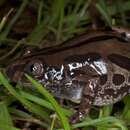Description
provided by AmphibiaWeb articles
A medium-sized (both sexes 25-40 mm, in South Africa up to 49 mm), ground-dwelling Kassina from the tropical savannas throughout Africa, pattern variable but normally grey with a black middorsal stripe and additional black spots and stripes, often forming dorsolateral stripes. Gular flap strap-like. Small swellings at the tips of toes and fingers. Inner metatarsal tubercle smaller than the internarial distance.There is a considerable geographical variation throughout the vast range of Kassina senegalensis which has given rise to separation into a number of species and subspecies. Although the differences in size and pattern can be dramatic in some parts of Africa it is currently thought that separation into subspecies is not necessary, among other reasons because we do not know the delimitation of the different forms or whether they merge gradually into each other.Two very distinct forms can be separated from the rest however, and could very well deserve nomenclatorical recognition. One of these is rather large, grey with round or oblong black spots on dorsum instead of stripes. Unspotted grey specimens occur. This form has been found in the very dry savanna, from Singida in northern Tanzania through Tsavo N. P. in Kenya to eastern and southern Ethiopia and Somalia. The name K. senegalensis somalica (Scortecci 1932) or K. somalica has been applied to this distinctive and geographically well-defined form (termed form 2 in Schiøtz 1975). Balletto et al. (1978) and Lanza (1981) record it as K. somalica, widespread through Somalia.The other distinct form is a population from northern and western Zambia. Specimens are large, with the dorsum densely beset with rather regular oblong spots (form 4 in Schiøtz 1975). The strange thing is that another large spotted Kassina, K. kuvangensis, similar in pattern, is found in the same area.In coastal Somalia to coastal Kenya a small striped form (form 3 of Schiøtz) occurs which seems almost to meet K. somalica with no evidence of intergradation. Baletto et. al. and Lanza regard this form in Somalia as a distinct species, K. argyreivittis Peters 1854, but it merges into the ordinary widespread K. senegalensis further south as shown by Poynton & Broadley 1987. Strangely, Tandy & Drewes (1985) indicate that the voice of this form appears to differ structurally from that of other recorded populations of K. senegalensis.Voice. - In the rainy season the voice of K. senegalensis is the most typical sound of the night in the African savanna, next to the fine xylophone-like notes of the even more abundant Hyperolius viridiflavus. It is a popping sound with a well-defined, fast rising frequency-intensity maximum. The timbre varies along with body size of the different populations. They often call in large numbers, the males responding to each other's call.This account was taken from "Treefrogs of Africa" by Arne Schiøtz with kind permission from Edition Chimaira (http://www.chimaira.de/) publishers, Frankfurt am Main.
- Balletto, E., Cherchi, M. A., and Lanza, B. (1978). ''On some amphibians collected by the late Prof. Guiseppe Scortecci in Somalia.'' Monitore Zoologico Italiano Supplemento, 11(9), 221-243.
- Lanza, B (1981). ''A check-list of the Somali amphibians.'' Monitore Zoologico Italiano Supplemento, 15(10), 151-186.
Distribution and Habitat
provided by AmphibiaWeb articles
As presently understood abundantly distributed throughout the entire tropical savanna of Africa.
Life History, Abundance, Activity, and Special Behaviors
provided by AmphibiaWeb articles
Development. - The eggs are placed under water adhered to vegetation. The clutch size is 260-400. The tadpoles have a very high tail fin and move slowly and gracefully. They can be large, up to 80 mm, and are dark with red or golden markings. Tooth formula 1/1+1,1.

